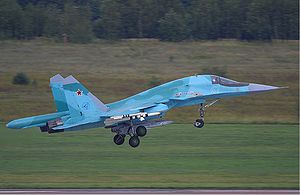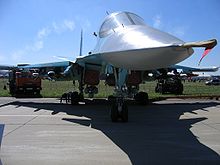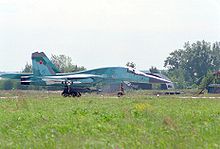Sukhoi Su-34 Videos
|
Loading...
|
|
Sukhoi Su-34
Su-34

Picture - Su-34 taking off
Role: Fighter-bomber
Manufacturer: Sukhoi
First flight: 13 April 1990
Introduced: Operational capability expected in 2010
Status: In early production/operational testing
Primary user: Russian Air Force
Produced: 2007-current
Number built: 12 as of 2009
Unit cost: US$36 million (1997)
Developed from: Sukhoi Su-27
The Sukhoi Su-34 (Russian: СÑÑ Ð¾Ð¹ СÑ-34) (export designation: Su-32, NATO reporting name: Fullback) is an advanced Russian 2-seat fighter-bomber. It is intended to eventually replace the Sukhoi Su-24 and the Tupolev Tu-22M.
Development
A dedicated fighter bomber version of the Sukhoi Su-27, first developed from the 1980s for the Soviet Union (with the Sukhoi bureau designation T-10V), it made its first flight on 13 April 1990 and was originally designated Su-27IB (IB: Istrebitel Bombardirovshchik / Fighter Bomber). It was developed in parallel with the two-seat naval trainer, the Su-27KUB (KUB: Korabelnyy Uchebno-Boyevoy, shipboard combat trainer), although, contrary to earlier reports, the two aircraft are not directly related.

Picture - Frontal view of the Su-34
Budget restrictions led the program to stall repeatedly, and led to the prototype aircraft being displayed publicly under a variety of roles and designations. When first described in the official Russian press in 1994 it was described as the Su-34. The third pre-production aircraft was shown at a Paris Air Show in 1995 as the Su-34FN (FN for "Fighter, Navy"), described as a shore-based naval aircraft, and it was displayed as the Su-34MF (MF for MnogoFunksionalniy, multi-function) at the MAKS air show in 1999. At the 1999 Paris Air show the aircraft was nicknamed the Platypus due to the unusual shape of the nose. The Russian Air Force has apparently recently adopted the designation Su-34.
The aircraft shares most of its wing structure, tail, and engine nacelles with the Su-27/Su-30, with canards like the Su-30MKI/Su-33/Su-27M/35 to increase static instability (higher maneuverability) and to reduce trim drag. The aircraft has an entirely new nose and forward fuselage with a cockpit providing side-by-side seating for a crew of two. The Su-34 retains the Su-27's engines, but with fixed intakes, limiting its maximum speed to Mach 1.8+.
Procurement
To date only a handful of pre-production models have been built. In mid-2004 Sukhoi announced that low-rate production was commencing and that initial aircraft would reach squadron service around 2008. Nevertheless, upgrade programs continue for surviving Russian Sukhoi Su-24, as the Su-34 may still not enter wide service for some years to come.
In March 2006, Russia's minister of defense Sergei Ivanov announced that the government had purchased only two Su-34s for delivery in 2006, and planned to have a complete air regiment of 44 Su-34s operational by the end of 2010. A total of 200 aircraft will be purchased by 2015 to replace some 300 Su-24s, which are going through modernisation upgrades currently to prolong their service life. Ivanov claimed that because the aircraft is "many times more effective on all critical parameters" the Russian Air Force will need far fewer of these newer bombers than the old Su-24 it replaces. The Su-34 will also replace Tupolev Tu-22Ms.
In December 2006, Ivanov revealed that approximately 200 Su-34s were expected be in service by 2020. This was confirmed by Air Force chief Vladimir Mikhaylov on March 6, 2007. Two Su-34s were delivered on 4 January 2007, and six more will be delivered by the end of that year. On 9 January 2008, Sukhoi reported that the Su-34 has begun full-rate production. At this time Russia planned to have 24 Su-34s operational by late 2010 with 70 to be purchased by 2015.
In June 2009, Sukhoi was awarded a five-year contract for Su-34 production. As of January 2010, the Russian Air Force plans to have 32 Su-34s in service by 2015.
Design

Picture - Su-34 landing
Performance
The Su-34 has a three surface planform, with a conventional horizontal tail at the rear and a pair of canard foreplanes in front of the wings for extra lift and more maneuvering power. The Su-34 has an active-safety system with artificial-intelligence elements. This system enables the plane to execute just about any stunt and combat maneuver and to fly at near ground level at a maximum speed of 1,400 km/h (765 kts). The Su-34 can also fly in TERCOM (Terrain Contour Matching) mode, bypassing unexpected obstacles and streaking through ground air-defense zones. The plane's crew can therefore conduct effective bombing runs, take evasive action, destroy enemy weapons and steer clear of missiles and anti-aircraft shells.
The Su-34 has 12 pylons for up to 8,000 kilograms (17,635 lb) of ordnance, intended to include the latest Russian precision-guided weapons. It retains the Su-27/Su-30's 30 mm GSh-30-1 cannon. The Su-34 ordnance load includes subsonic and supersonic homing missiles and glider bombs, can destroy hardened and well-camouflaged targets at a range of up to 250 km. The airplane has enlarged capacity internal fuel tanks for practical unrefueled flight of 4,000 kilometres (2,160 nm). With three refuelings, the Su-34 is capable of covering a distance of more than 14,000 kilometres (7,560 nm). The onboard electronics engineering ensures the flight crew with a full information about parameters of flight and enclosing space, condition of onboard systems and power plant, purposes in an air on ground, on surface of water and under water, about means of radar-tracking detection and REF of the opponent, about AD and degree of threat, created by them concerns to one from the important features of a new airplane. In addition, the Su-34 features a rearward facing radar capable of detecting, tracking, and directing R-73 or R-77 AAMs at pursuing enemy aircraft.
An operational mission for the Su-34 begins with a mission planning period that loads into the aircraft's two main computers the coordinates and elevations of every navigation and mission-dependent point from takeoff to landing. At each coordinate-point or time-hack, automatic switching of modes can be accomplished so that the pilots can be hands-off or involved with other parts of the mission. Data link with command aircraft, ground stations, and command ships will be maintained and where line-of-sight limits are reached these communications resort to satellites for expanded coverage. Mission updates can be passed by higher authority anytime during the flight. All types or tactical and strategic ordnance can be utilized with emphasis being placed on long range standoff weapons such as the Kh-59 Ovod/Kh-59ME cruise missiles, Kh-29 & Kh-31 anti-radiation weapons, Kh-35 Uran anti-ship weapon, and the Kh-41 Moskit long range anti-ship missile.
Cockpit and avionics
Unlike the earlier Su-27, the Su-34 has a modern glass cockpit, with colour CRT multi-function displays. Its avionics currently are based around a Leninets V004 passive electronically scanned array radar, and a UOMZ laser/television system for designating and guiding precision-guided munitions. The front-mounted radar is supplemented by a rear-aspect V005 radar housed in the long tail "stinger". The Su-34 is equipped with comprehensive ECM equipment, including an infrared missile launch detection system.
The avionics suite has an extended architecture of computers, memory boards, color multi-function displays, and processors designed as self-contained information processing modules. They consist of large Argon digital computer units with specially programmed processors that use multiplex data-exchange channels. All information modules are controlled by a dual central computing system that fully coordinates workload and provides all relevant information to the flight deck. Two-way data link enables the mission planning and weapon aim-point computations to be loaded or updated while in flight or aircraft to aircraft. As a penetrating attack aircraft, the Su-34 incorporates an advanced multi-function phased array radar capable of terrain following and avoidance for high speed, low level operations.
The Su-34's most distinctive feature is the unusually large flight deck. Much of the design work went into crew comfort. The two crew members sit side by side in a large cabin, with the pilot-commander to the left and navigator/operator of weapons to the right in NPP Zvezda K-36dm ejection seats. An advantage of the side by side cockpit is that duplicate instruments are not required for each pilot. As long missions require comfort, it has pressurization that it allows to operate up to 10,000 metres (32,800 ft) without oxygen masks, which are available for emergencies and combat situations. The crew members have room to stand and move about the cabin during long missions. The space between the seats allows them to lie down in the corridor, if necessary. A small toilet and a galley are located behind the crew seats.
A long-range surveillance radar, passive detection systems, system of communication for tactical and strategic voice and data in a single platform with long-range capacity with flight refuelling, transform the Su-34 into a way of monitoring and recognition in real time and platform of command and control, forming a complete battle management system.
Operational history
The Su-34's long range was shown in a July 2010 exercise when Su-34s and Su-24Ms were moved from Russian bases in Europe to one on the Pacific coast, 6,000 kilometers away, which requires in-flight refueling. The Su-24Ms were refueled three times, while the Su-34 was refueled twice.
Operators
Russia
Russian Air Force - 16 with 32 more on order as of 2008 total of 48 by 2013 Although, the actual number of Su-34's in service is a military secret.
Former operators
Soviet Union
Soviet Air Force - 2 prototypes, 1 complete
Specifications (Su-34)
Data from Sukhoi data, Gordon and Davison AF Technology
General characteristics
Crew: Two
Length: 23.34 m (72 ft 2 in)
Wingspan: 14.7 m (48 ft 3 in)
Height: 6.09 m (19 ft 5 in)
Loaded weight: 39,000 kg (85,980 lb)
Useful load: 8,000 kg (17,600 lb)
Max takeoff weight: 45,100 kg (99,425 lb)
Powerplant: 2x Lyulka AL-31FM1 turbofans, 13,500 kgf (132 kN, 29,762 lbf) with afterburner each
Performance
Maximum speed:
High altitude: Mach 1.8 (1,900 km/h, 1,180 mph)
Low altitude: Mach 1.2 (1,400 km/h, 870 mph) at sea level
Combat radius: 1,100 km (680 mi)
Ferry range: 4,000 km (2,490 mi)
Service ceiling: 15,000 m (49,200 ft)
Wing loading: 629 kg/m² (129 lb/ft²)
Thrust/weight: 0.68
Armament
1 x 30 mm GSh-30-1 (9A-4071K) cannon, 180 rounds
Defensive weapons include the R-27 Alamo, R-73 Archer and R-77 Adder series, with the PESA providing the capability to track ten targets and concurrently engage four with BVR missile shots.
10 x wing and fuselage stations for up to 8,000 kg (17,630 lb) of ordnance, including Kh-29L/T (AS-14), Kh-25MT/ML/MP (AS-10), Kh-36 (?), Kh-38, Kh-41 (?), Kh-59M (AS-18), Kh-58 (AS-11), Kh-31P (AS-17), Kh-35 Ural (AS-20), Kh-65S, Kh-SD, 2 Moskit, 3 x Jachont air-to-ground missiles, KAB-500L/KR or KAB-1500L guided bombs, unguided bombs, B-8 rocket pods with 20 x 80 mm S-8 rockets, B-13 rocket pods with 5 x 122 mm S-13 rockets, O-25 rocket pods with 1 x 340 mm S-25 rocket, fuel tanks, EW- and reconnaissance pods.
Related development
Su-27
Su-30
Su-33
Su-35
Comparable aircraft
General Dynamics F-111 Aardvark
McDonnell Douglas F-15E Strike Eagle
Panavia Tornado
Sukhoi Su-24
Tupolev Tu-22M
Gordon, Yefim and Peter Davison. Sukhoi Su-27 Flanker, Specialty Press, 2006. ISBN 978-1-58007-091-1.
Living Warbirds: The best warbirds DVD series.
Source: WikiPedia